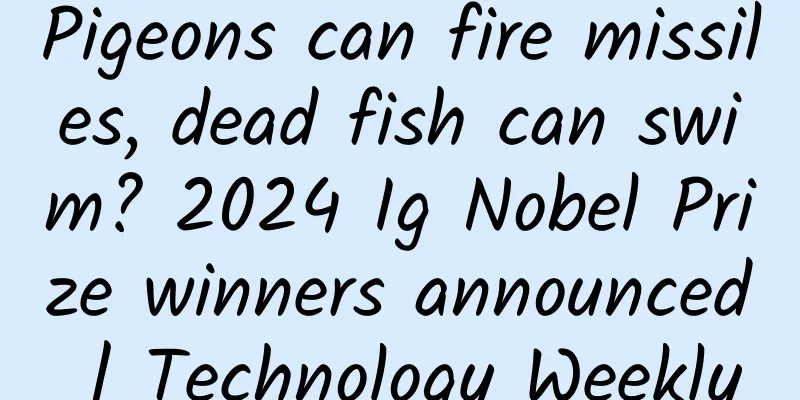Pigeons can fire missiles, dead fish can swim? 2024 Ig Nobel Prize winners announced | Technology Weekly

|
Compiled by Zhou Shuyi and Wang Xiang Blood sugar-lowering "magic drug" may reverse aging Metformin is one of the most widely used oral hypoglycemic drugs in the world. It is not only safe, has few adverse reactions, but is also economical and cheap. After more than 60 years of clinical practice, it has become the first-line drug for the treatment of type 2 diabetes. Interestingly, in recent years, new effects of metformin have emerged: weight loss, cardiovascular protection, improvement of blood lipid metabolism, improvement of non-alcoholic fatty liver disease (NAFLD), treatment of polycystic ovary syndrome (PCOS), and even prevention and treatment of cancer. A new study published in Cell on September 12 found new evidence for another potential effect of metformin: the study confirmed for the first time in primates that metformin can significantly delay aging, especially protect the brain cognitive function of elderly primates. This effect does not rely on its blood sugar regulation effect, but delays cell aging by "resetting" the intrinsic program of cell aging. Studies have shown that metformin can activate the transcription factor Nrf2 and enhance the antioxidant capacity of cells, promoting the rejuvenation of various cells including neurons. The research team conducted a 40-month metformin intervention study on healthy middle-aged and elderly cynomolgus monkeys (equivalent to 40-50 years old in humans). Metformin was given daily at a dose equivalent to that of human diabetes treatment, and a comprehensive evaluation was conducted using more than 60 indicators including cognitive behavior, physiological function, medical imaging, and blood tests. The results showed that long-term use of metformin can effectively delay the aging of multiple organs such as the liver, heart, lung, small intestine, and skeletal muscle of primates, reduce periodontal bone loss and cerebral cortex atrophy, and significantly improve the cognitive function of elderly primates. Considering the long life span of primates, it is technically not feasible to evaluate the effect of aging interventions using only life span and mortality. The researchers analyzed 11 systems and 79 tissues and organs in crab-eating macaques, and constructed a multi-dimensional biological age "clock" for primate tissues and organs using machine learning models and multi-omics data. The evaluation found that metformin can significantly reduce the DNA methylation age, gene transcription age, and plasma protein age of multiple tissues and organs in primates, especially in the frontal lobe of the brain, and the reversal age can reach 6 years, which is equivalent to 18 years old in humans. The researchers said that the new study further proves that aging is an analyzable, quantifiable and controllable biological process, and that the primate aging clock can be reversed through a single drug intervention, providing a new path for delaying aging and the prevention and treatment of related diseases. It is understood that the Chinese Academy of Sciences has jointly conducted a "Phase II Exploratory Clinical Study on Metformin Regulating the Health of Middle-aged and Elderly People" with the Xuanwu Hospital of Capital Medical University to test whether oral metformin can effectively intervene in the aging of middle-aged and elderly men. "AI Test Solver" is here, OpenAI releases a new generation of large model "o1" On September 12, local time, artificial intelligence giant OpenAI officially released a new generation of large model "o1", and also released a faster and lower-cost version o1-mini. Compared with previous models, o1's characteristics are closer to humans: it can spend more time "thinking" and solve more complex natural science, programming and mathematical problems through deep reasoning. OpenAI said that the new model marks a milestone in AI's complex reasoning ability, so the series code is reset to "1". o1 is internally codenamed "Strawberry", independent of the GPT model series, which is still under development. What is special about o1 is that it no longer completes the chain of thought (CoT) purely through prompting, but regards it as a means of "thinking" and integrates it into the training and reasoning process. The chain of thought is a prompting method. The main idea is to encourage large models to explain their reasoning steps, thereby leading to more accurate results. In the training stage, o1 uses reinforcement learning (RL) to better use the chain of thought to "think". It can split complex problems into simple steps, identify and correct errors, and try different methods. In the reasoning stage, the model will introduce a longer internal chain of thought and spend more time "thinking" about the problem. OpenAI said that as the reinforcement learning time and thinking time increase, the performance of o1 will continue to improve. This opens up a new dimension beyond the model parameter quantity, data set size, and computational complexity of the traditional model performance scaling laws. By interpreting the thought chain, we can understand the "inner heart" of the model and its thinking process. However, the thought chain is not aligned. For reasons such as user experience and maintaining competitive advantage, o1 does not expose the original thought chain to users, but only displays the summary generated by the model. o1 performs well in tasks that require high reasoning, such as mathematics and programming, and is far ahead of GPT-4o. In the 2024 American Invitational Mathematics Competition (AIME), o1 scored an average of 74%, while GPT-4o scored only 12%. If sampled 1,000 times and weighted voted, o1 would score 93%, ranking among the top 500 in the United States. In another test, o1 and GPT-4o submitted anonymous answers to open-ended questions in different fields, and humans voted for their preferred answers. o1 is significantly better than GPT-4o in programming, data analysis, and mathematical calculations, but slightly inferior in writing and editing. OpenAI scientist Noam Brown said that o1 is not perfect and sometimes even makes mistakes on simple questions. Many people have tried to use similar examples to prove that "large language models cannot reason", but o1 has made great progress in this regard and can go further. Now, o1 needs to think for a few seconds; future versions will not only not be faster, but will be slower - thinking for hours, days or even weeks. "The cost of reasoning will go up, but how much are you willing to pay for the development of new anti-cancer drugs? For breakthrough batteries? To prove the Riemann hypothesis? AI can be more than just a chatbot." 2024 Ig Nobel Prize winners announced: Anuses can breathe, pigeons can fire missiles, and dead fish can swim On September 12, local time, the 2024 Ig Nobel Prize was announced at the Massachusetts Institute of Technology (MIT). The Ig Nobel Prize is a funny imitation of the Nobel Prize. It was established in 1991 by Marc Abrahams, editor of the Annals of Improbable Research, to recognize scientific achievements that make people "laugh and then think deeply." The winning research includes ten achievements, including "Mammals can breathe through their anuses", "Observing the swimming ability of dead trout", and "Pigeons firing missiles". The blackboard in MIT Building 10, Room 250, where the awards ceremony was held, with chalk drawings created on site by artist Keira Lee Rice. Here is the full list of the 2024 Ig Nobel Prize winners: Physiology Prize: For the discovery that many mammals can breathe through their anus. Japanese researchers have found that mammals such as mice and pigs can "breathe" by absorbing oxygen through the rectum. Their experiments showed that perfusing oxygen or oxygenated liquids into the rectum can significantly increase the blood oxygen level of mammals, provide them with important life support, and reverse the symptoms of respiratory failure in mouse and pig models. They started this study during the epidemic, when many hospitals were extremely short of ventilators to support critically ill patients. Physics Prize: Rainbow trout can swim even after death. To Professor James Liao of the University of Florida, he conducted a comprehensive study on the swimming ability of dead rainbow trout. Under certain conditions, when fluids such as air and water bypass obstacles, two columns of staggered vortices are generated. This phenomenon is called "Karman vortex street" and is very common in life. The uniqueness of rainbow trout is that they like to stay near the Karman vortex street and swim with a unique "Karman gait". This posture is so energy-saving that even dead fish can swim in the Karman vortex street and even swim upstream. "I found that live fish swim faster than dead fish, but not much faster. A dead rainbow trout is dragged behind a stick, and it will also slap its tail to the rhythm of the water flow." Botany Prize: For the discovery that some real plants mimic the shapes of neighboring artificial plastic plants. The Anatomy Prize: For studying the effects of living in the northern or southern hemisphere on the direction of hair swirl. Medicine Prize: Placebos with a slight burning side effect may be more effective. Probability Prize: For showing through theoretical analysis and 350,757 experiments that when you toss a coin, it tends to land on the same side as it did before you toss it. Chemistry Prize: For separation of drunken and sober worms by chromatography. Demographics Award: For discovering that areas known for long life expectancy often have poor birth and death records and are prone to pension fraud. Biology Award: To explore the factors that affect the lactation of cows by placing a cat on their back and then exploding a paper bag next to them to scare the cows. Amateur astronaut completes world's first commercial spacewalk At about 6:00 a.m. Eastern Time on September 12 (about 18:00 Beijing Time), two crew members of the U.S. "Polaris Dawn" space mission began to take turns to go out of the cabin. This is the world's first commercial spacewalk by non-professional astronauts. The "Polaris Dawn" mission team consists of four non-professional astronauts. They took the "Dawn" spacecraft to launch from the Kennedy Space Center in Florida on the 10th for a multi-day space journey. Jared Isaacman successfully exited the warehouse. The spacewalk mission was carried out by Jared Isaacman, 41, founder and CEO of Shift4Pay, an American payment service provider, and Sarah Gillis, an engineer at SpaceX. SpaceX's live broadcast on social media X showed that the spacecraft was at an orbital altitude of 732.2 kilometers from the ground at the time. The extravehicular activity officially began at 6:12 a.m. Eastern Time on the 12th (18:12 Beijing Time). Isaacman and Gillis wore the extravehicular activity space suits designed by the company and left the cabin one after another. They stayed outside the cabin for about 12 minutes respectively, during which they conducted mobility tests on the space suits. For safety reasons, the two kept one hand or foot on a ladder-like support structure at the hatch of the spacecraft during their stay outside the cabin. A 3.6-meter cable connected them to the spacecraft. The other two crew members, Kidd Poteet and Anna Menon, monitored the entire process in the cabin. Since the entire cabin was in a depressurized environment, the two also wore the company's designed extravehicular activity space suits during the mission. Including safety checks and cabin repressurization procedures, the entire mission lasted about two hours. The Polaris Dawn mission is jointly funded by Isaacman and SpaceX. The mission team has launched a series of scientific research and experiments, including testing the communication between the spacecraft and the Starlink satellite, and studying the effects of space flight and space radiation on human health. (CCTV News) American man uses AI to create hundreds of thousands of fake songs The New York Times reported on September 5 that a man in North Carolina, the United States, was accused of using artificial intelligence (AI) to create hundreds of thousands of songs under a fabricated band name, uploading them to streaming music platforms, and manipulating robot "trolls" to increase the number of plays. Although each play could only bring in a meager royalty income, the accumulated royalties amounted to more than 10 million US dollars by the time the crime was exposed. The report said that the man is named Michael Smith, 52 years old, and was originally a famous musician. In 2018, he cooperated with the CEO of an AI music company to release thousands of AI-produced songs, and made up the song titles, bands, and composers in a serious manner, and put them on streaming media to earn a share. For example, the song titles are "Zygotic Washstands", "Zymotechnical", and "Zygophyllum", which are from the hands of "Callous Post", "Calorie Screams", "Calvinistic Dust" and others. But in fact, they have neither skills nor emotions, they are all AI. In a February email, Smith boasted that his songs had been streamed 4 billion times and had earned $12 million in royalties since 2019. In October 2018, a company notified Smith that it had received "multiple reports of streaming abuse" and was preparing to remove his songs from all platforms. Smith categorically denied: "Absolutely impossible! Ridiculous! God and God's conscience! How can I go through the legal channels?" Today, Smith faces multiple charges including wire fraud and conspiracy to launder money. my country's reusable rockets make new breakthroughs According to Xinhua News Agency, at noon on September 11, my country's independently developed Zhuque-3 VTVL-1 reusable vertical take-off and landing recovery test rocket completed a 10-kilometer-level vertical take-off and landing return flight test at the Jiuquan Satellite Launch Center, marking a breakthrough in my country's commercial aerospace technology in reusable launch vehicle technology, and a key step towards achieving large-capacity, low-cost, high-frequency, reusable space launches in the future. This mission is the first time in China to achieve secondary ignition of a vertical take-off and landing return rocket in the air, joint guidance and control of "grid rudder-cooling air attitude control-engine" in a transonic high dynamic pressure environment, and engineering application of high-altitude wind real-time wind repair technology. The test went through the process of "ascent-engine shutdown-unpowered taxiing-engine secondary start in the air-soft landing", and all indicators met the expected design. According to experts from Blue Arrow Aerospace, the test rocket is a single-stage liquid oxygen-methane rocket with a body diameter of 3.35 meters, a length of 18.3 meters, a takeoff mass of approximately 68 tons, a takeoff thrust of 800 kilonewtons, and is equipped with three sets of landing cushion legs and a new four-piece grid rudder system. It uses the same high-strength stainless steel body structure as the Suzaku-3 rocket. It is equipped with an improved 80-ton Tianque-12 (TQ-12) liquid oxygen-methane engine of the same type as the Suzaku-3 rocket, which has achieved continuous orbital flight verification. It has orthogonal double pendulum, variable thrust adjustment from 45% to 111%, and multiple ignition capabilities. The test rocket for this mission is an engineering prototype built with a full-size engine, which is an important part of the development of Blue Arrow Aerospace's reusable rocket project. Through two vertical take-off and landing recovery tests, the model team successfully verified a number of key technologies for reusable rockets, laying the foundation for the future maiden flight and recovery of Suzaku-3. Dry eyes? A smile can be as effective as eye drops Laughter is a form of expression, and it varies from person to person. A gentleman smiles, a beautiful lady smiles. Not only that, a study published in The BMJ on September 11 showed that laughter is also a good medicine: "Laughter exercise" is as effective as artificial tears (0.1% sodium hyaluronate) in treating dry eyes. This suggests that laughter may be an effective, safe, low-cost and environmentally friendly intervention method, and can be used as a first-line treatment for dry eyes. Dry eyes are one of the most common eye diseases. Its main symptoms include dry eyes, sore eyes, foreign body sensation, etc., which seriously affect patients' vision and quality of life. Recent studies have shown that dry eyes are a lifestyle-related disease, closely related to psychological states such as depression and anxiety. Through clinical observation, the research team found that "laughter training" can relieve anxiety and depression while also improving the discomfort symptoms of dry eyes. In order to further understand the therapeutic effect of "laughter training" on dry eyes, researchers conducted a prospective, non-inferiority randomized controlled clinical study. The study included 299 eligible symptomatic dry eye patients and randomly divided them into two groups. One group of 150 people received conventional artificial tears (i.e., sodium hyaluronate with a concentration of 0.1%); the other group of 149 people received "laughter training" and recorded the intervention throughout the process. In this study, the "laughter training" is a set of commands designed by the research team based on facial and eye muscle movements. The patients repeat the commands to form exaggerated expressions to simulate the state of laughter. 30 times of the commands constitute one training session, and the training is conducted 4 times a day. The commands are: "hihihi (pinyin spelling), hahahaha, eggplant eggplant, 7up 7up 7up, hahahahahahaha". The results showed that after 8 weeks of intervention, the symptoms and eye signs of patients in the "laugh training" group and the artificial tears group improved. In the primary outcome indicator "ocular surface disease index" score (an indicator to measure the subjective severity of dry eyes), the "laugh training" group was not inferior to the artificial tears group, and even better than the artificial tears group in improving some eye signs. Liang Lingyi, the project leader and deputy director of the Zhongshan Eye Center of Sun Yat-sen University, said that this study confirmed the therapeutic effect of "laughter training" on dry eye patients and proposed an effective, safe, low-cost and environmentally friendly non-drug treatment from a new perspective. "Laughter training" may improve the stability of the tear film and the function of the meibomian glands, and the research team is conducting further research on the related biological mechanisms. Special Tips 1. Go to the "Featured Column" at the bottom of the menu of the "Fanpu" WeChat public account to read a series of popular science articles on different topics. 2. Fanpu provides a function to search articles by month. Follow the official account and reply with the four-digit year + month, such as "1903", to get the article index for March 2019, and so on. Copyright statement: Personal forwarding is welcome. Any form of media or organization is not allowed to reprint or excerpt without authorization. For reprint authorization, please contact the backstage of the "Fanpu" WeChat public account. |
>>: Mooncake trivia | Can you believe it? Fruit mooncakes are actually made of winter melon!
Recommend
Behind the WeChat outage response: pretentious texts, powerless users
WeChat had a malfunction yesterday afternoon, and...
The ten most powerful mythical beasts in "Classic of Mountains and Seas": Kunpeng, which devours everything, can only be at the bottom, and the auspicious beast Bai Ze cannot be in the top three?
As a famous ancient book of strange stories in my...
Is plant-based meat healthier than animal-based meat?
Plant-based meats are slightly inferior to animal...
Retention or virus? What should a product focus on in its early stages?
Many companies ask the question “How do we acquir...
How come people still trust Baidu when its paid ranking is so shady?
(1). 1. Regarding bidding ranking, you may not kn...
Lu Mingming's "Xiaohongshu Fan Training Course 5.0" helps you easily play Xiaohongshu platform
Course Contents: 01.Understand the value of Xiaoh...
Meituan Operations: The Marketing Logic of Meituan Takeaway Monthly Card
Buy monthly pass at super low price First, let’s ...
Google will abandon RenderScript in Android 12 and switch to Vulkan
Google announced today that with the launch of An...
How to use the points system to stimulate user retention (Part 1): Classification and definition of points
The so-called points system is based on points. B...
Event promotion planning!
Activities are a very important way to quickly at...
What is the difference between personal payment code and merchant payment code? How to change to merchant payment code?
Personal payment codes are now built-in modules o...
Exclusive interview with Qiniu President Lv Guihua: Let cloud services penetrate into life
[[134122]] Cloud has become one of the hottest to...
Android P enters public beta, these 15 changes are worth noting
At the I/O 2018 conference that just ended, we sa...
7 content models for corporate TikTok accounts
What is the most popular social short video platf...
Daily Youxian event traffic generation tips!
In the past, when we went to the supermarket to b...









